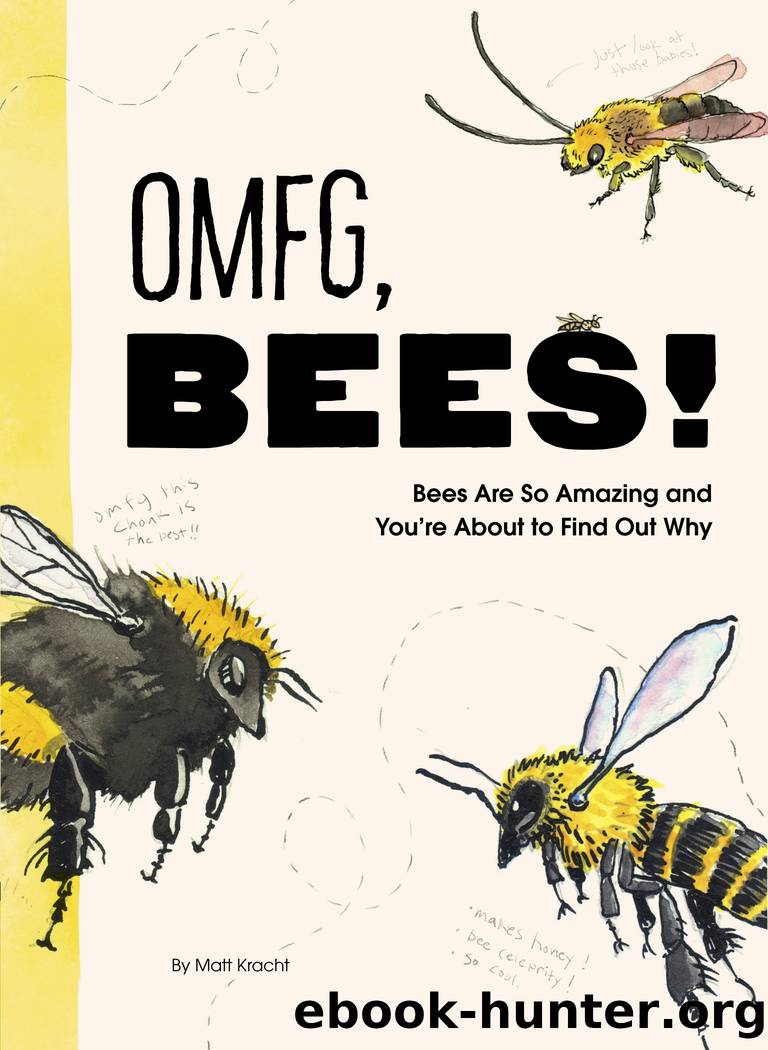OMFG, BEES! by Matt Kracht

Author:Matt Kracht
Language: eng
Format: epub
Publisher: Chronicle Books LLC
Youâre Pollen My Leg
It looks like colorful powder, but pollen is really the microspores of a seed plant and, if youâre a bee, itâs gonna get stuck all over your fuzzy little body. Thereâs no avoiding it. As a bee travels from flower to flower, pollen gets carried from the male structures of one plant to the female structures of another, where plant fertilization occurs, and boom! Thatâs pollination.
A bee might visit between 50 and 1,000 plants per day to gather pollen, depending on how much pollen those plants have available. An average colony of honeybees needs to collect about 100 pounds [45.4 kg] of pollen per season because it is a critical part of a beeâs diet. Pollen provides a key source of protein, carbohydrates, vitamins, and minerals, as well as other nutrients. This is why theyâre always messing around in those flowers.
But how exactly do they collect that pollen and transport it back to the colony? You might be thinking, âOh, I know the answer to this one,â but donât get cocky, because you probably donât know the whole story and the other half is going to blow your mind.
As a bee flies through the air, the extreme rapid flapping of her wings builds up a positive static electric charge. âNo way!â you think, but yes way, electrically charged bees are flying around everywhere all the time.
The pollen grains of a flower hold a negative charge, and when a bee lands in a flower, that fine pollen gets shaken loose from the flowerâs anther. It is attracted to the positively charged hairs on the beeâs body, so it just leaps onto the bee without her even having to touch it.
By the way, there is a study showing some evidence that bees can actually sense the electric field of flowers with their hairs and, if a flower has lost too much of its negative charge, they know it has been depleted of pollen by other bees, and will avoid wasting effort and move on to a flower with a better energy field.
Mind blown? Youâre welcome.
After collecting all that pollen to her like a superhero with magnetic abilities, the bee uses her legs to wipe the pollen from her body either onto her abdomen or, depending on the species of bee, her hind legs. Admittedly, this is a much less impressive way to move pollen around, but who am I to criticize?
Once back in the nest, the forager cleans herself off and unloads her pollen haul into waiting pollen storage cells near the brood nest. It will be used to feed the young. And also those lazy-ass drones, at least until theyâre no longer needed for breeding.
Download
This site does not store any files on its server. We only index and link to content provided by other sites. Please contact the content providers to delete copyright contents if any and email us, we'll remove relevant links or contents immediately.
Sapiens: A Brief History of Humankind by Yuval Noah Harari(14043)
The Tidewater Tales by John Barth(12457)
Mastermind: How to Think Like Sherlock Holmes by Maria Konnikova(7014)
Do No Harm Stories of Life, Death and Brain Surgery by Henry Marsh(6741)
The Thirst by Nesbo Jo(6554)
Why We Sleep: Unlocking the Power of Sleep and Dreams by Matthew Walker(6434)
Life 3.0: Being Human in the Age of Artificial Intelligence by Tegmark Max(5261)
Sapiens by Yuval Noah Harari(5169)
The Longevity Diet by Valter Longo(4909)
The Body: A Guide for Occupants by Bill Bryson(4687)
The Rules Do Not Apply by Ariel Levy(4617)
The Immortal Life of Henrietta Lacks by Rebecca Skloot(4323)
Why We Sleep by Matthew Walker(4237)
Animal Frequency by Melissa Alvarez(4227)
The Hacking of the American Mind by Robert H. Lustig(4155)
Yoga Anatomy by Kaminoff Leslie(4150)
All Creatures Great and Small by James Herriot(4063)
Double Down (Diary of a Wimpy Kid Book 11) by Jeff Kinney(4013)
Barron's AP Biology by Goldberg M.S. Deborah T(3983)
